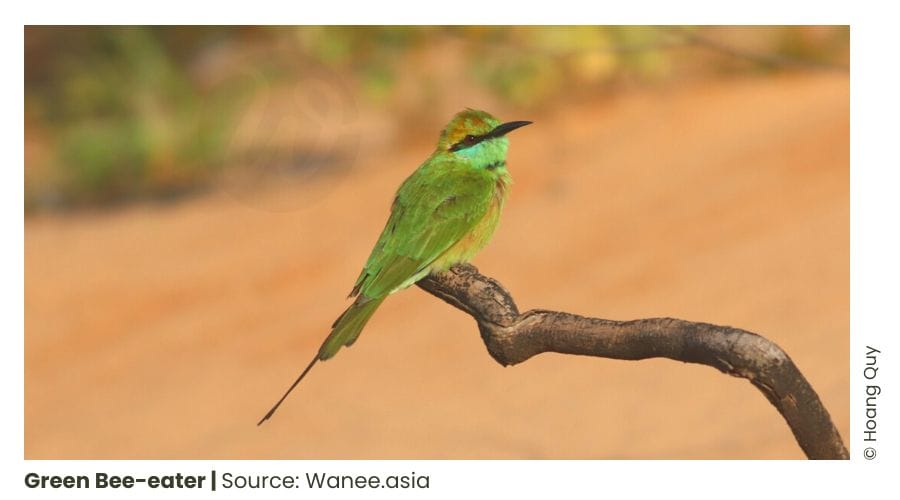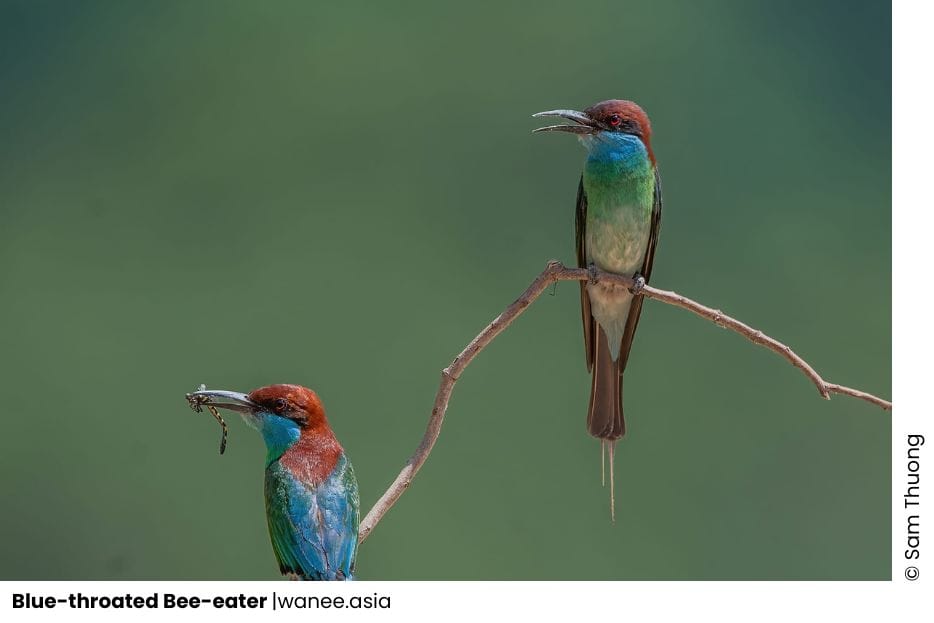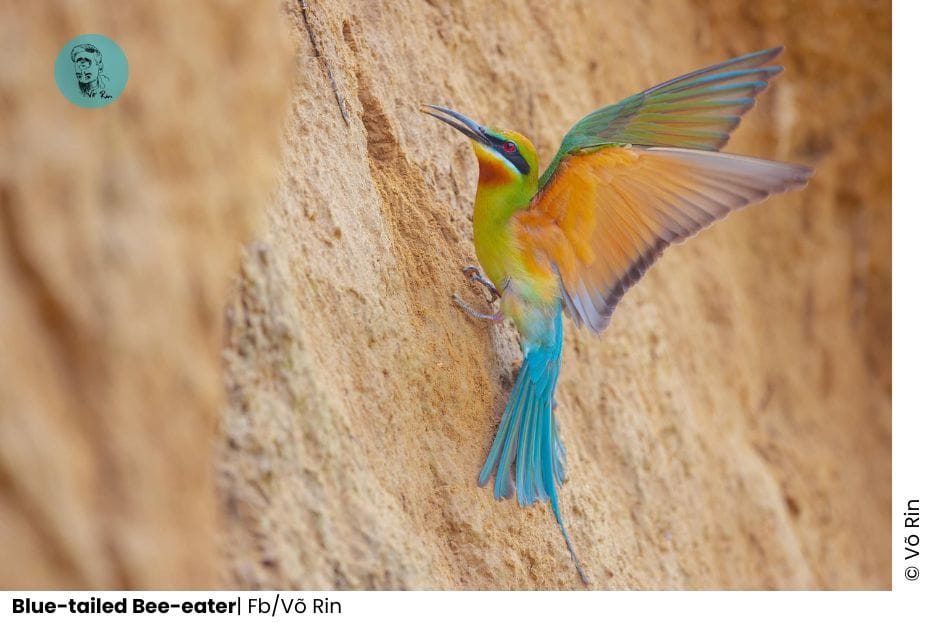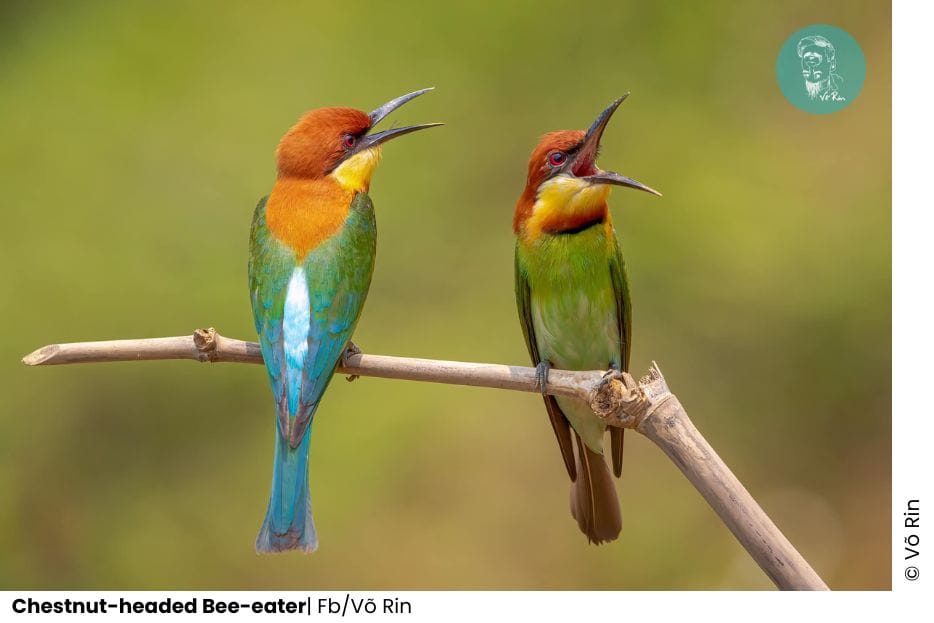Bee-eaters of Vietnam – Meropidae
With 5 species Bee-eaters of Vietnam, this is one of another family that has a number of species fewest in Vietnam. But it is not really hard to encounter them in Vietnam because most of all live even near people and nature. Mostly they have a small size except for Blue-beared Bee-eater. A Bee-eater has a Falcon size.
You may know Bee-eater really love to keep their feather clean. They spend more than 3 hours per day on this. It includes sunning, dust bathing, and water bathing.
The overview of Bee-eaters families
The Bee-eaters are a group of non-passerine birds in the family Meropidae, containing three genera and thirty species. Most species are found in Africa and Asia, with a few in southern Europe, Australia, and New Guinea. They are characterized by richly colored plumage, slender bodies, and usually elongated central tail feathers. All have long down-turned bills and medium to long wings, which may be pointed or round. Male and female plumages are usually similar.
As their name suggests, bee-eaters predominantly eat flying insects, especially bees and wasps, which are caught on the wing from an open perch. The insect’s stinger is removed by repeatedly hitting and rubbing the insect on a hard surface. During this process, pressure is applied to the insect’s body, thereby discharging most of the venom.
Most Bee-eaters are gregarious. They form colonies, nesting in burrows tunnelled into vertical sandy banks, often at the side of a river or in flat ground. As they mostly live in colonies, large numbers of nest holes may be seen together. The eggs are white, with typically five to the clutch. Most species are monogamous, and both parents care for their young, sometimes with assistance from related birds in the colony.
Bee-eaters may be killed by raptors; their nests are raided by rodents, weasels, martens and snakes, and they can carry various parasites. Some species are adversely affected by human activity or habitat loss, but none meet the International Union for Conservation of Nature’s vulnerability criteria, and all are therefore evaluated as “least concern”. Their conspicuous appearance means that they have been mentioned by ancient writers and incorporated into mythology.
Are you looking for Wildlife Tours in Vietnam?
WANEE VIETNAM is your go-to destination for "Wildlife Tours in Vietnam", specializing in Birding, Primate Watching, Herping, Photography Tours and Educational Tours led by our expert guides.Bee-eaters of Vietnam species note

Blue-bearded Bee-eater Nyctyornis athertoni
Status: Fairly Common resident (throughout)
Best time to watch & Photo: All Year
Tour cover: Throughout
Hotspot: Dinh Mout, Cat Tien, Ma Da

Green Bee-eater Merops orientalis
Status: Fairly Common resident (throughout)
Best time to watch & Photo: All Year
Tours: Exclude Northern Vietnam
Hotspot: Cat Tien, Tan Phu, Go Cong

Blue-throated Bee-eater Merops viridis
Status: Uncommon resident in southern & Rare pass Migrant in North of Central
Best time to watch & Photo: Feb-Apr
Tours: South Vietnam
Hotspot: Cat Tien, Phong Nha – Ke Bang

Blue-tailed Bee-eater Merops philippinus
Status: Fairly Common resident (throughout)
Best time to watch & Photo: Feb-Apr
Tours: South & Coastline Central
Hotspot: Tram Chim, Can Gio, Cat Tien

Chestnut-headed Bee-eater Merops leschenaulti
Status: Local fairly common resident
Best time to watch & Photo: Feb-Apr
Tours: South of Central to Mekong Delta
Hotspot: Tram Chim, Cat Tien, Da Lat
All Vietnam Birds Families
Vietnam Birding Tours at WANEE
Across Vietnam, conservation efforts are expanding—from reforestation projects to wildlife rescue and habitat protection. At WANEE, we believe that the more we appreciate nature, the more we’ll want to protect it. That’s why our tours are designed to inspire a deeper love for wildlife and a stronger commitment to conservation. While trying harder every day to protect the balance of nature, our wildlife tours give tourists the chance to explore Vietnam’s natural beauty, understand how different habitats connect, and take action to protect them.
For bee-eater enthusiasts, Vietnam is home to several species of these colorful, acrobatic birds known for their striking plumage and impressive flight skills. To observe them, we offer wildlife tours to open woodlands, riverbanks, and grasslands, where they can be seen catching insects mid-air and displaying their vibrant colors.
Scheduled Wildlife Tours
Tailored Wildlife Tours
Click here to see more tailored tour options
Visit our sites:
– Facebook: WANEE Vietnam (Wild and Nature Exploring)
– Instagram: WANEE Vietnam and WANEE Kids hub
Are you looking for Wildlife Tours in Vietnam?
WANEE VIETNAM is your go-to destination for "Wildlife Tours in Vietnam", specializing in Birding, Primate Watching, Herping, Photography Tours and Educational Tours led by our expert guides.Hot-spot for Birding in Vietnam
all birding in hot-spot informative info [updated Jan 2023]
Nr. Nature reserve; Np. National Park; mt. Mountain
Crocodile Trail – The Best Birding Trail in Cat Tien National Park
If you’re a birder or nature photographer planning a trip to Vietnam, few places offer [...]
Cong Troi Trail – Top 1 Dalat Plateau Birding Trail Experience
If you’re a birder or nature photographer planning a trip to Vietnam’s Central Highlands, the [...]
How to Identify the Greater Sand Plover, Tibetan Sand Plover and Siberian Sand Plover
Identification Differences within the Sand Plover Complex: The sand plover group, which was traditionally divided [...]
Highlights of Cat Tien National Park Reptiles and Amphibian Endemics
Spanning over 71,350 hectares of tropical forests, grasslands, and wetlands, Cat Tien National Park is [...]
Highlights of Cat Tien National Park Mammals in a World Biosphere Reserve
In addition to reptiles and birds, Cat Tien National Park is also rich in mammals, [...]
Kontum Plateau Endemic and Highlight bird
Kontum Plateau Endemic And Highlight Bird species like Chestnut-eared Laughingthrush and top birding routes while [...]